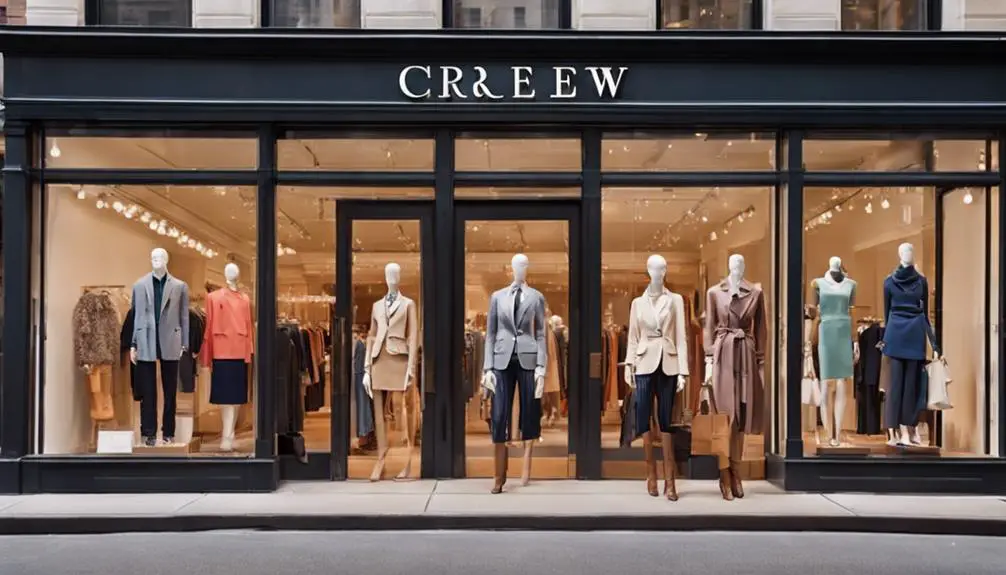When you think about J.Crew, you might conjure images of classic American style paired with a modern twist. But what does the brand truly signify in today's fashion landscape? It's more than just a label; it reflects a journey of evolution, from its origins aiming to compete with high-end brands to its current status as a staple for many. Understanding J.Crew's meaning requires you to contemplate its financial ups and downs, leadership changes, and unique marketing strategies. So, how does this all tie together in the broader context of fashion?
Origins of the Brand

J.Crew's origins trace back to 1983 when Arthur Cinader launched the brand with the name "Crew," aiming to compete directly with Ralph Lauren's Polo label. J.Crew began as a bold endeavor, designed to carve out a niche in the competitive fashion market. By adding the letter "J," Cinader aimed to infuse the brand with a sense of sophistication and appeal to a broader audience, setting the stage for its future success.
As J.Crew evolved, it embraced a commitment to quality craftsmanship, often featuring vintage item characteristics that resonate with today's fashion enthusiasts.
Initially, J.Crew gained traction through its innovative catalogs, which showcased editorial-worthy photography and embodied a glamorous American lifestyle. You'll notice that the brand's clean-cut aesthetic, featuring striped tees and crisp shorts, perfectly resonated with the preppy culture of the 1980s. This connection considerably boosted its popularity, as consumers sought to emulate the polished, collegiate look that J.Crew offered.
What truly helped J.Crew solidify its status as a preppy powerhouse was its association with "The Official Preppy Handbook." This influential book not only highlighted the preppy lifestyle but also positioned J.Crew as a leading name in the market.
As you explore the brand's history, you'll appreciate how these early efforts laid the groundwork for J.Crew's enduring legacy in American fashion. Each step of J.Crew's journey reflects a savvy understanding of consumer desires, allowing the brand to thrive and evolve in an ever-changing landscape.
Evolution of J.Crew
However, by the late 1990s, J.Crew encountered an identity crisis, struggling to adapt to the rapidly shifting fashion landscape. This decline in sales and relevance called for a drastic change.
Enter Mickey Drexler, appointed CEO in 2003, who became the catalyst for J.Crew's revitalization. He redefined the brand with a curated collection that spoke to modern consumers and promoted Jenna Lyons as the creative director, leading to a fresh, stylish vision.
Under Drexler's leadership, J.Crew embraced celebrity endorsements, particularly with Michelle Obama donning their pieces. This association not only elevated the brand's image but also greatly boosted sales, cementing J.Crew's place in contemporary fashion.
By aligning with modern style and influence, J.Crew transformed itself into a go-to label for those seeking timeless yet trendy apparel.
Today, J.Crew stands as a reflection of the power of strategic evolution, continually adapting to meet the desires of its audience while staying true to its roots.
Financial Journey

The financial journey of J.Crew has been marked by significant highs and lows, reflecting the brand's ongoing struggle to navigate its market position. You might recall that J.Crew went public in 2006, raising an impressive $376 million through an IPO that sold 33% of its expanded capital.
However, the tides turned when the company faced a $3 billion leveraged buyout in 2011, which led to substantial debt accumulation. With $787 million in dividends owed to investors, J.Crew found itself in a precarious financial situation.
Fast forward to 2017, when the company faced severe challenges that prompted job cuts and management changes, all in an effort to stabilize amid declining sales. The situation took a drastic turn when J.Crew filed for Chapter 11 bankruptcy on May 4, 2020, largely due to the impacts of COVID-19 combined with its existing debt burden.
However, the story doesn't end there. After restructuring, J.Crew emerged from bankruptcy in September 2020, showcasing resilience.
Under the guidance of the CEO of J.Crew, the brand reported a remarkable recovery, with Q4 2019 net income at $1.5 million, a notable bounce back from a staggering $74.4 million loss in the same quarter the previous year.
This financial turnaround reflects the brand's adaptability and commitment to overcoming challenges, proving that J.Crew is more than just a fashion retailer; it's a demonstration of perseverance in the face of adversity.
Leadership Transformations
What drives a brand's success more than its leadership? At J.Crew, this question resonates deeply, especially given its recent history of leadership transformations. Mickey Drexler, appointed CEO in 2003, was instrumental in revitalizing the brand after a challenging decade in the 1990s. His vision not only reinvigorated J.Crew's image but also paved the way for creative director Jenna Lyons, whose innovative style and keen eye for product curation played a significant role in the brand's resurgence.
Together, they crafted a fresh aesthetic that resonated with consumers, ultimately becoming a hallmark of J.Crew's identity. This period marked substantial growth, with J.Crew establishing itself as a benchmark for competitors, thanks in part to their collaborations with designers and impactful advertising campaigns.
However, the winds of change often blew too fiercely. After Drexler, James Brett took the helm in November 2018, but his leadership was short-lived, leading to the formation of an "office of the CEO." Jan Singer followed, stepping into the CEO role in January 2020, only to be succeeded by Libby Wadle in November of the same year.
This frequent turnover raised concerns about J.Crew's strategic direction and operational effectiveness in a fiercely competitive retail landscape.
While the leadership changes have created uncertainty, the legacy of Drexler and Lyons reminds us of the profound impact strong leadership can have on a brand's trajectory. As J.Crew navigates these challenges, it's essential to remember that effective leadership isn't just about making decisions; it's about inspiring a vision that aligns with consumer desires and market trends.
Marketing Strategies

As J.Crew navigates the challenges posed by leadership changes, its marketing strategies play a pivotal role in maintaining brand relevance and consumer loyalty. The brand's approach has evolved considerably over the years, adapting to market trends and consumer preferences.
Similar to L.L. Bean's marketing approach, you might remember the iconic J.Crew catalog, historically issued 24 times a year, which showcased the brand's products and lifestyle. While this frequency has decreased since 2017, J.Crew continues to capture attention through engaging online content and targeted advertising campaigns.
In 2018, J.Crew launched a loyalty program designed to enhance customer engagement, offering perks like free shipping, exclusive promotions, and even birthday gifts. This initiative not only rewards loyal customers but also fosters a sense of community, encouraging shoppers to feel connected to the brand.
Additionally, J.Crew has embraced contemporary social issues in its advertising, sparking conversations around gender identity and demonstrating its commitment to relevance in today's society.
Collaborative collections with designers like Engineered Garments and Christopher John Rogers have also added unique flair to the J.Crew lineup, diversifying its offerings and attracting new customers.
The brand's shift towards casual wear, including the popular J.Crew Factory line and athleisure styles, highlights its response to a growing demand for comfort and versatility in fashion. By staying attuned to these trends, J.Crew continues to resonate with consumers, proving that its marketing strategies aren't just about selling clothes, but about building a lifestyle that customers can embrace.




